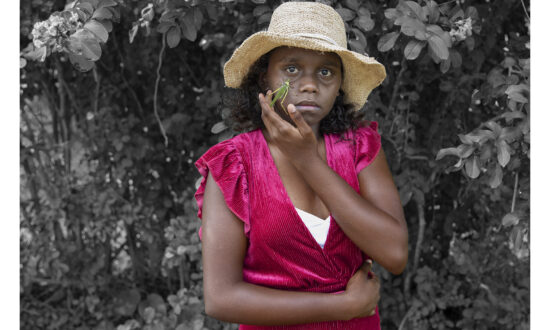Daniel Boyd dedicates one wall of his Rainbow Serpent (Version) exhibition to the Captain James Cook monument that stands in the town that carries his name in Queensland’s far north. James Cook spent seven weeks in Cooktown during his 1770 voyage of “discovery”.
His presence in this outpost is marked with a monumental cenotaph, more than 8m tall, designed by Queensland colonial architect George St Paul Connolly, who was Boyd’s ancestor. Cook’s time in Queensland, no matter how significant his individual achievements, is a smudge compared with the custodianship of the Guugu Yimithirr peoples, which spans 60,000 years. Yet it is Cook’s name and legacy that is commemorated here, looming over Guugu Yimithirr Country.
In Daniel Boyd: Rainbow Serpent (Version), now showing at Brisbane’s Institute of Modern Art, Boyd’s paintings of the monument are overwritten by the signature dotted pattern that screens imagery in his paintings. It is a lens designed to reframe our perspectives (also referring to the pixilation of photography and associated with Aboriginal art).
A smaller painting of the entire monument is paired with a much larger canvas detailing the Corinthian patterning at the cenotaph’s top (Untitled (WITSOC), 2023). The scale of the Corinthian column (a connection to ancient Greece and modern democracy) is veiled by dots to note the dispossession Cook’s visit cast over the country and Australia’s First Nations peoples.
“This iteration of Rainbow Serpent (Version) looks at the remnants of the expansion of empire from this particular site of Queensland,” Boyd explains. “It thinks about how we relate to the landscape or site. It has also been an opportunity for me to do some research into a European part of my family. An ancestor’s brother was one of the state colonial architects in Brisbane, so I’ve looked at parts of his legacy and what his involvement was in this kind of place-making project.”
A reflective black floor with mirror dots takes this screen into an imaginative installation that alone occupies the largest gallery, where it is enlivened by the movement of visitors (Untitled, 2023). Boyd’s family connections extend far and wide— he is a Kugjala, Ghungalu, Wangerriburra, Wakka Wakka, Gubbi Gubbi, Kuku Yalanji, Bundjalung and Yuggera man —and into Vanuatu. His Yuggera heritage makes the site of the IMA in Brisbane’s Fortitude Valley personal for him.

Get InReview in your inbox – free each Saturday. Local arts and culture – covered.
Thanks for signing up to the InReview newsletter.
“The mirrored floor responds to the site in a more immediate way,” he says. “It offers the opportunity to think about the site as a sort of stage to be activated by different voices and lived experiences.”
Also personal is his painting of a photograph of himself as a child, held by his mother, juxtaposed with First Nations subjects, found in studio portraits taken nearby in the 1870s. These faces from the past become part of Boyd’s contemporary reclamation in a way that is emotive, poignant and engaging. His heritage is connected to those individuals who have been recorded in photographs but not named.
Boyd’s practice is an imaginative approach to disrupting and reframing our view of Australia’s colonial histories. It prompts an attitudinal shift — an erosion, gentle and beautiful, of the endemic whiteness in our built environment.
This is Boyd’s first survey exhibition in Brisbane (a partnership with Berlin’s Gropius Bau). Across the Brisbane River, his work also features prominently in Queensland Art Gallery’s Living Patterns: Contemporary Australian Abstraction exhibition, where his abstracted mirrored lenses line the entry walls.
Daniel Boyd: Rainbow Serpent (Version), Institute of Modern Art, Judith Wright Arts Centre, Fortitude Valley, Brisbane, until December 16
ima.org.au
Support local arts journalism
Your support will help us continue the important work of InReview in publishing free professional journalism that celebrates, interrogates and amplifies arts and culture in South Australia.
Donate Here




